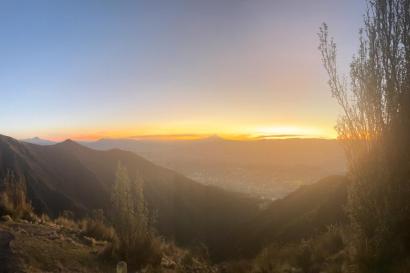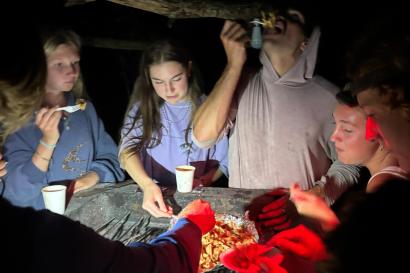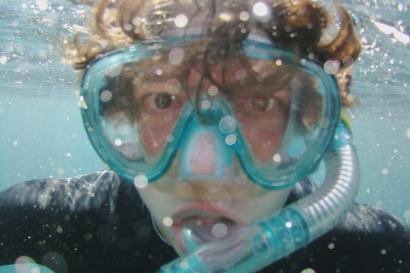Here in Ecuador’s central valley, it seems every direction you turn points towards some fantastical adventure. The twin ridge lines squeezing the valley’s waist each hold a couple volcanic peaks each, and roads snake up from Quito’s suburban sprawl into stunted elfin forest, terraced pasture, and dew-laden paramo. High Andean lakes glitter up there, their baby blue water stirred by glacier-chilled winds, and beneath them cloud banks feed the mosses that cover every inch of available wood. Crossing over the ridgelines, you find the clouds again, butting up against an impassable barrier and soaking the slopes below til stream beds run coffee-brown and trails collapse beneath your feet. Epiphytes reach out from their near vertical holdfasts, collecting the rain, and the leaves of a thousand tree species bob up and down in the shower.
You might not know all this, hanging out to a reggaeton beat and sipping an iced drink on the cobbled streets of Cumbaya. At night the air is thick and rich and fragrant, pulsing with restless energy. One could be totally content eating maracuya ice cream in the park and listening to a street musician coax melodies from a beaten-up guitar.
I was thinking about that serene scene one Saturday night in nearby Mindo as a friend and I hiked up to the lodge we were staying at in the early hours of the morning. It was humid, buggy, and, aside from the heat lightning hiccuping occasionally in the distance, impenetrably dark. We had stayed out too late with the rest of our group at their AirBnB, missed the last taxi, and were now questioning our decision to stay deep in the forest—this was a long uphill walk, after all. We had heard a Barn Owl screech overhead as we’d left town, but as we trekked through the forest it was shockingly quiet. Frogs wailed and crickets whined, but nothing with feathers made a sound. We were drained. It was late. Was this worth it?
Nearing the lodge, we stopped to catch our bearings before a rickety rope bridge. The river beneath, swollen with recent rainwater, thrashed and foamed in wild abandon. We only had to go a little further, right? Relief, at last? We could almost taste it (maracuya ice cream, maracuya ice cream…)
And then, above our heads, we heard the heavy flutter of soft wings and the rapid clicking of an echo-locator. Flashlights spun upwards, expletives sputtered uncontrollably—and there it was. Huge and demonic, a ghastly muppet in wobbling levitation, this Oilbird was a species we hadn’t dared hope to encounter here. Like a cross between an owl and a swallow (more of a nightjar actually), this denizen of deep jungle spends the days tucked away in wet caves and emerges at night to eat fruit in the canopy, using echolocation to map the treetops beneath its loose, ungainly wings. Such a wild life history has lent the species an almost mythic status, the kind of reputation that supersedes the bird itself. The name “Oilbird” begins to stand for something greater, a signifier of a deep wild and the extremities of class aves. The wonder of it all washed over us as we stood looking skyward, mouths agape and brains humming with muggy delirium. The bird fluttered overhead in wide circles, occasionally passing through the broad beam of our light but always melting back into the dark. The night was deep. The forest, we sensed, was even deeper—a place of legend, of discovery, of stories interconnected like mats of mycelium beneath an icing of decay. How did we get here?
The Oilbird was just one of almost 160 bird species I observed during four days in the Mindo area, two of which were part of a field trip with my GIS class. I can honestly say it was the greatest field trip of my life, a transect through the diverse habitats of the Andes’ west slope where we gained hands-on experience with the ways GPS tracking can tell stories across the medium of maps and landscapes. On our second morning, doing a topographic survey in the forest understory, we found bushwhacking the best way to both mark survey points and uncover cool insects; it also got us hot and filthy and necessitated a swim in the stream (my hesitancy caved fast). As the various field groups converged on the bank and worked up the will to plunge beneath the sepia surface (our professor, Leo, cheered us on) chatter and laughter and the splash of new-confidences taking root joined a chorus of cloud forest birdsong. Mud squelched beneath our toes, the water surprisingly cold.
I don’t really know how to express the joy and wonder of this past month. Any anecdote I choose feels arbitrary, one piece of an intricate jigsaw, barely even hinting at the beauty of the whole. Do I describe a group hike up to the base camp at Volcan Cotopaxi (16,000 feet) where we sheltered from the howling winds with hot chocolate and threw around snowballs in the fog? Do I talk about locally-brewed blackberry ale and conversations so good you’re an hour late for dinner? Condors soaring above the cliffs of Antisana? The hum of rain on the roof of a canopy tower as your socks hang on wicker chairs to dry?
I suppose there is one anecdote that deserves more time.
This past weekend, a bunch of students and I bussed down to the town of Banos, a splash of color nestled in a mountain pass several hours south of Quito. Our plans for the weekend were initially rather typical—some hiking, some canyoning, a dip in a hot spring or two. Yet, coming off of our previous weekend in Mindo, a new goal had arisen: I was in easy striking distance of my 1,000th bird. I had touched down in Ecuador talking of this milestone and what it meant to me, and after three weeks I’d closed the gap…with help. What had previously been a solely personal endeavor—my quest for new species—now felt communal. Every student in the program had played a role, and so it only felt fitting that I’d hit 1,000, that weekend, with a team. And so it was that, on Saturday afternoon, several of us were nestled in a cloud on a ridge top above town. Rope swings carried people out into the mist, off the edge of the world, and the tangled forest dropped off sharply beneath our feet. A flurry of bird activity caught my attention: #998, Pale-naped Brushfinch. #999, Saffron-crowned Tanager. Any moment now. We broke off down a side path, narrow through a hall of moss. A clearing opened, a flash of color settled on a bush top. This was it. #1,000: Lacrimose Mountain Tanager.
Blue, yellow, black and shimmering like an opal, this bird will never know the place it now holds in my story, and ours. It doesn’t need to. High fives, hugs, tears and smiles flashed just like brilliant feathers in the fog, a gift traded across taxa. Here were people I’d known for mere weeks, celebrating the culmination of a lifetime—and it was a celebration that lasted late into the night.
I’ve spent my whole life working to share my love for the natural world with the people around me. I’ve given tours, talks, led groups of bright-eyed children through the woods and land-lubbers across whitecaps to whales. Yet I have never felt my love shared like I did then—then and now—here in this wonderful place kissed by clouds and gleaming bright in dew and color.
Gracias, my amigos. Gracias, Ecuador.
Próxima parada: las islas Galápagos.
Stay tuned.
Ciao,
Brendan

Brendan Murtha
<p>Hi everyone! My name is Brendan, and I'm a junior at Bowdoin College (Brunswick, ME) studying Ecology, Evolution, and Marine Biology. I'm passionate and curious about all things natural history related, and although my main focus has always been birds, I am just as likely to be found photographing dragonflies or catching snakes as I am craning my neck to look at the skies. These interests have also led me down paths of human ecology, conservation, and all things political, and I enjoy exploring such topics in my writing, photography, and music. I'm super excited to be part of the GAIAS program this semester, and hope to capture some of the magic through my posts.</p>








